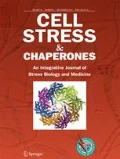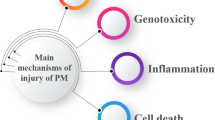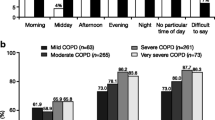Abstract
This case-control study aimed to investigate whether the levels of Hsp70 (HSPA1A) and Hsp27 (HSPB1) in plasma and lymphocytes were associated with the risk of chronic obstructive pulmonary disease (COPD) among coal workers. A total of 76 COPD cases and 48 age-matched healthy controls from a group of coal workers were included. The case group consisted of 35 COPD patients whose condition was complicated with coal workers’ pneumoconiosis (CWP) and 41 COPD patients without CWP. Heat shock proteins (Hsps) in plasma and lymphocytes were detected by ELISA and flow cytometry, respectively. Multiple logistic regression models were applied to estimate the association between Hsp levels and COPD risk. Our results showed that plasma Hsp70 and lymphocyte Hsp27 levels were significantly higher and plasma Hsp27 levels were significantly lower in COPD cases than in controls (p < 0.01). No significant differences in lymphocyte Hsp70 levels were found between COPD cases and the matched subjects. Higher plasma Hsp70 levels (odds ratio (OR) = 13.8, 95 % confidence interval (CI) = 5.7–33.5) and lower plasma Hsp27 levels (OR = 4.6, 95 % CI = 2.0–10.5) were significantly associated with an increased risk of COPD after adjusting for confounders. Higher lymphocyte Hsp27 levels were only associated with an increased risk of COPD with CWP (OR = 6.6, 95 % CI = 2.0–22.1) but not with an increased risk of COPD without CWP (OR = 3.0, 95 % CI = 0.9–8.9). Additionally, there were strong joint effects of different Hsps on COPD risk. These results showed that higher levels of plasma Hsp70 and lower levels of plasma Hsp27 might be associated with an increased risk of COPD among coal workers. They may have the potential to serve as monitoring markers for COPD in coal workers.

Similar content being viewed by others
References
Abboud R, Vimalanathan S (2008) Pathogenesis of COPD. Part I. The role of protease-antiprotease imbalance in emphysema [State of the Art Series. Chronic obstructive pulmonary disease in high-and low-income countries. Edited by G. Marks and M. Chan-Yeung. Number 3 in the series]. Int J Tuberc Lung Dis 12(4):361–367
Agustı A, Noguera A, Sauleda J, Sala E, Pons J, Busquets X (2003) Systemic effects of chronic obstructive pulmonary disease. Eur Respir J 21(2):347–360
Arrigo AP (2007) The cellular "networking" of mammalian Hsp27 and its functions in the control of protein folding, redox state and apoptosis. Adv Exp Med Biol 594:14–26. doi:10.1007/978-0-387-39975-1_2
Asea A, Kraeft S-K, Kurt-Jones EA, Stevenson MA, Chen LB, Finberg RW, Koo GC, Calderwood SK (2000) HSP70 stimulates cytokine production through a CD14-dependant pathway, demonstrating its dual role as a chaperone and cytokine. Nat Med 6(4):435–442
Asea A, Rehli M, Kabingu E, Boch JA, Baré O, Auron PE, Stevenson MA, Calderwood SK (2002) Novel signal transduction pathway utilized by extracellular HSP70 role of Toll-like receptor (TLR) 2 and TLR4. J Biol Chem 277(17):15028–15034
Bachelet M, Mariéthoz E, Banzet N, Souil E, Pinot F, Pollal CZ, Durand P, Bouchaert I, Polla BS (1998) Flow cytometry is a rapid and reliable method for evaluating heat shock protein 70 expression in human monocytes. Cell Stress Chaperones 3(3):168
Bøyum A (1976) Isolation of lymphocytes, granulocytes and macrophages. Scand J Immunol 5(s5):9–15
Campisi J, Leem TH, Fleshner M (2003) Stress-induced extracellular Hsp72 is a functionally significant danger signal to the immune system. Cell Stress Chaperones 8(3):272
Castranova V, Vallyathan V (2000) Silicosis and coal workers' pneumoconiosis. Environ Health Perspect 108(Suppl 4):675
Chen W, Zhuang Z, Attfield M, Chen B, Gao P, Harrison J, Fu C, Chen J, Wallace W (2001) Exposure to silica and silicosis among tin miners in China: exposure-response analyses and risk assessment. Occup Environ Med 58(1):31–37
Chen W, Liu Y, Wang H, Hnizdo E, Sun Y, Su L, Zhang X, Weng S, Bochmann F, Hearl FJ (2012) Long-term exposure to silica dust and risk of total and cause-specific mortality in Chinese workers: a cohort study. PLoS Med 9(4):e1001206
Chung K, Adcock I (2008) Multifaceted mechanisms in COPD: inflammation, immunity, and tissue repair and destruction. Eur Respir J 31(6):1334–1356
De AK, Kodys KM, Yeh BS, Miller-Graziano C (2000) Exaggerated human monocyte IL-10 concomitant to minimal TNF-α induction by heat-shock protein 27 (Hsp27) suggests Hsp27 is primarily an antiinflammatory stimulus. J Immunol 165(7):3951–3958
Dong J, Guo L, Liao Z, Zhang M, Zhang M, Wang T, Chen L, Xu D, Feng Y, Wen F (2013) Increased expression of heat shock protein 70 in chronic obstructive pulmonary disease. Int Immunopharmacol 17(3):885–893
Gan W, Man S, Senthilselvan A, Sin D (2004) Association between chronic obstructive pulmonary disease and systemic inflammation: a systematic review and a meta-analysis. Thorax 59(7):574–580
Gómez FP, Rodriguez-Roisin R (2002) Global Initiative for Chronic Obstructive Lung Disease (GOLD) guidelines for chronic obstructive pulmonary disease. Curr Opin Pulm Med 8(2):81–86
Gosset P, Lassalle P, Vanhee D, Wallaert B, Aerts C, Voisin C, Tonnel AB (1991) Production of tumor necrosis factor-alpha and interleukin-6 by human alveolar macrophages exposed in vitro to coal mine dust. Am J Respir Cell Mol Biol 5(5):431–436. doi:10.1165/ajrcmb/5.5.431
Gruden G, Barutta F, Catto I, Bosco G, Caprioli MG, Pinach S, Fornengo P, Cavallo-Perin P, Davini O, Cerrato P (2013) Serum levels of heat shock protein 27 in patients with acute ischemic stroke. Cell Stress Chaperones 18(4):531–533
Hacker S, Lambers C, Hoetzenecker K, Pollreisz A, Aigner C, Lichtenauer M, Mangold A, Niederpold T, Zimmermann M, Taghavi S (2009) Elevated HSP27, HSP70 and HSP90 alpha in chronic obstructive pulmonary disease: markers for immune activation and tissue destruction. Clin Lab 55(1–2):31–40
Hendrick JP, Hartl F (1993) Molecular chaperone functions of heat-shock proteins. Annu Rev Biochem 62(1):349–384
Hino M, Kurogi K, Okubo MA, Murata-Hori M, Hosoya H (2000) Small heat shock protein 27 (HSP27) associates with tubulin/microtubules in HeLa cells. Biochem Biophys Res Commun 271(1):164–169. doi:10.1006/bbrc.2000.2553
Jan Ankersmit H, Nickl S, Hoeltl E, Toepker M, Lambers C, Mitterbauer A, Kortuem B, Zimmermann M, Moser B, Bekos C, Steinlechner B, Hofbauer H, Klepetko W, Schenk P, Dome B (2012) Increased serum levels of HSP27 as a marker for incipient chronic obstructive pulmonary disease in young smokers. Respiration 83(5):391–399. doi:10.1159/000336557
Júnior SÁ, Possamai F, Budni P, Backes P, Parisotto E, Rizelio V, Torres M, Colepicolo P, Wilhelm Filho D (2009) Occupational airborne contamination in south Brazil: 1. Oxidative stress detected in the blood of coal miners. Ecotoxicology 18(8):1150–1157
Kuempel ED, Stayner LT, Attfield MD, Buncher CR (1995) Exposure‐response analysis of mortality among coal miners in the United States. Am J Ind Med 28(2):167–184
Kuempel ED, Wheeler MW, Smith RJ, Vallyathan V, Green FH (2009) Contributions of dust exposure and cigarette smoking to emphysema severity in coal miners in the United States. Am J Respir Crit Care Med 180(3):257–264
Lancaster G, Møller K, Nielsen B, Secher NH, Febbraio MA, Nybo L (2004) Exercise induces the release of heat shock protein 72 from the human brain in vivo. Cell Stress Chaperones 9(3):276
Lindquist S, Craig E (1988) The heat-shock proteins. Annu Rev Genet 22(1):631–677
MacNee W, Rahman I (2001) Is oxidative stress central to the pathogenesis of chronic obstructive pulmonary disease? Trends Mol Med 7(2):55–62
Mannino DM, Buist AS (2007) Global burden of COPD: risk factors, prevalence, and future trends. Lancet 370(9589):765–773
Martin-Ventura JL, Nicolas V, Houard X, Blanco-Colio LM, Leclercq A, Egido J, Vranckx R, Michel J-B, Meilhac O (2006) Biological significance of decreased HSP27 in human atherosclerosis. Arterioscler Thromb Vasc Biol 26(6):1337–1343
Meijers J, Swaen G, Slangen J (1997) Mortality of Dutch coal miners in relation to pneumoconiosis, chronic obstructive pulmonary disease, and lung function. Occup Environ Med 54(10):708–713
Miller B, Jacobsen M (1985) Dust exposure, pneumoconiosis, and mortality of coalminers. Br J Ind Med 42(11):723–733
Miller MR, Hankinson J, Brusasco V, Burgos F, Casaburi R, Coates A, Crapo R, Enright P, van der Grinten CP, Gustafsson P, Jensen R, Johnson DC, MacIntyre N, McKay R, Navajas D, Pedersen OF, Pellegrino R, Viegi G, Wanger J (2005) Standardisation of spirometry. Eur Respir J 26(2):319–338. doi:10.1183/09031936.05.00034805
Morfeld PB, Schins RPF, Lenaerts H, Witte B, Derwall R, Piekarski C (2001) Cross sectional study on cytokine production (TNF-α, IL-8) in German coalminers with progressive massive fibrosis and in control miners using a rapid wholeblood assay. Biomarkers 6(6):428–439
Morteza A, Nakhjavani M, Larry M, Nargesi AA, Esteghamati A (2013) Heat shock protein 70 and albuminuria in patients with type 2 diabetes: a matched case control study. Cell Stress Chaperones 18(6):815–819
Nicks ME, O'Brien MM, Bowler RP (2011) Plasma antioxidants are associated with impaired lung function and COPD exacerbations in smokers. COPD 8(4):264–269. doi:10.3109/15412555.2011.579202
Njemini R, Lambert M, Demanet C, Mets T (2006) The effect of aging and inflammation on heat shock protein 27 in human monocytes and lymphocytes. Exp Gerontol 41(3):312–319
Oudijk ED, Lammers JJ, Koenderman L (2003) Systemic inflammation in chronic obstructive pulmonary disease. Eur Respir J 22(46 suppl):5s–13s
Panjwani NN, Popova L, Srivastava PK (2002) Heat shock proteins gp96 and hsp70 activate the release of nitric oxide by APCs. J Immunol 168(6):2997–3003
Pockley AG (2003) Heat shock proteins as regulators of the immune response. Lancet 362(9382):469–476
Rahman I, Morrison D, Donaldson K, MacNee W (1996) Systemic oxidative stress in asthma, COPD, and smokers. Am J Respir Crit Care Med 154(4):1055–1060
Rogalla T, Ehrnsperger M, Preville X, Kotlyarov A, Lutsch G, Ducasse C, Paul C, Wieske M, Arrigo A-P, Buchner J (1999) Regulation of Hsp27 oligomerization, chaperone function, and protective activity against oxidative stress/tumor necrosis factor α by phosphorylation. J Biol Chem 274(27):18947–18956
Saetta M, Di Stefano A, Maestrelli P, Ferraresso A, Drigo R, Potena A, Ciaccia A, Fabbri LM (1993) Activated T-lymphocytes and macrophages in bronchial mucosa of subjects with chronic bronchitis. Am Rev Respir Dis 147(2):301–306
Salari S, Seibert T, Chen Y-X, Hu T, Shi C, Zhao X, Cuerrier CM, Raizman JE, O’Brien ER (2013) Extracellular HSP27 acts as a signaling molecule to activate NF-κB in macrophages. Cell Stress Chaperones 18(1):53–63
Seibert TA, Hibbert B, Chen YX, Rayner K, Simard T, Hu T, Cuerrier CM, Zhao X, de Belleroche J, Chow BJ, Hawken S, Wilson KR, O'Brien ER (2013) Serum heat shock protein 27 levels represent a potential therapeutic target for atherosclerosis: observations from a human cohort and treatment of female mice. J Am Coll Cardiol 62(16):1446–1454. doi:10.1016/j.jacc.2013.05.041
Serneri G, Abbate R, Gori A, Attanasio M, Martini F, Giusti B, Dabizzi P, Poggesi L, Modesti P, Trotta F (1992) Transient intermittent lymphocyte activation is responsible for the instability of angina. Circulation 86(3):790–797
Srivastava P (2002) Interaction of heat shock proteins with peptides and antigen presenting cells: chaperoning of the innate and adaptive immune responses. Annu Rev Immunol 20(1):395–425
Vega VL, Rodríguez-Silva M, Frey T, Gehrmann M, Diaz JC, Steinem C, Multhoff G, Arispe N, De Maio A (2008) Hsp70 translocates into the plasma membrane after stress and is released into the extracellular environment in a membrane-associated form that activates macrophages. J Immunol 180(6):4299–4307
Vestbo J, Hurd SS, Agusti AG, Jones PW, Vogelmeier C, Anzueto A, Barnes PJ, Fabbri LM, Martinez FJ, Nishimura M, Stockley RA, Sin DD, Rodriguez-Roisin R (2013) Global strategy for the diagnosis, management, and prevention of chronic obstructive pulmonary disease: GOLD executive summary. Am J Respir Crit Care Med 187(4):347–365. doi:10.1164/rccm.201204-0596PP
Wang F, Feng M, Xu P, Xiao H, Niu P, Yang X, Bai Y, Peng Y, Yao P, Tan H (2009) The level of Hsp27 in lymphocytes is negatively associated with a higher risk of lung cancer. Cell Stress Chaperones 14(3):245–251
Wang H, Xing J, Wang F, Han W, Ren H, Wu T, Chen W (2010) Expression of Hsp27 and Hsp70 in lymphocytes and plasma in healthy workers and coal miners with lung cancer. Huazhong Univ Science and Technolog Med Sci 30:415–420
Xiao C, Wu T, Ren A, Pan Q, Chen S, Wu F, Li X, Wang R, Hightower LE, Tanguay RM (2003) Basal and inducible levels of Hsp70 in patients with acute heat illness induced during training. Cell Stress Chaperones 8(1):86–92
Zhang X, Xu Z, Zhou L, Chen Y, He M, Cheng L, Hu FB, Tanguay RM, Wu T (2010) Plasma levels of Hsp70 and anti-Hsp70 antibody predict risk of acute coronary syndrome. Cell Stress Chaperones 15(5):675–686
Acknowledgments
We are particularly grateful to all individuals who voluntarily participated in the study and to the doctors in the Central Hospital of Xishan Coal & Power Company for their generous help in the health examination and sampling of subjects. This study was supported by research funds from the National Basic Research Program of China (2011CB503804) and the National Natural Science Foundation of China (81372967).
Author information
Authors and Affiliations
Corresponding author
Rights and permissions
About this article
Cite this article
Cui, X., Xing, J., Liu, Y. et al. COPD and levels of Hsp70 (HSPA1A) and Hsp27 (HSPB1) in plasma and lymphocytes among coal workers: a case-control study. Cell Stress and Chaperones 20, 473–481 (2015). https://doi.org/10.1007/s12192-015-0572-5
Received:
Revised:
Accepted:
Published:
Issue Date:
DOI: https://doi.org/10.1007/s12192-015-0572-5




